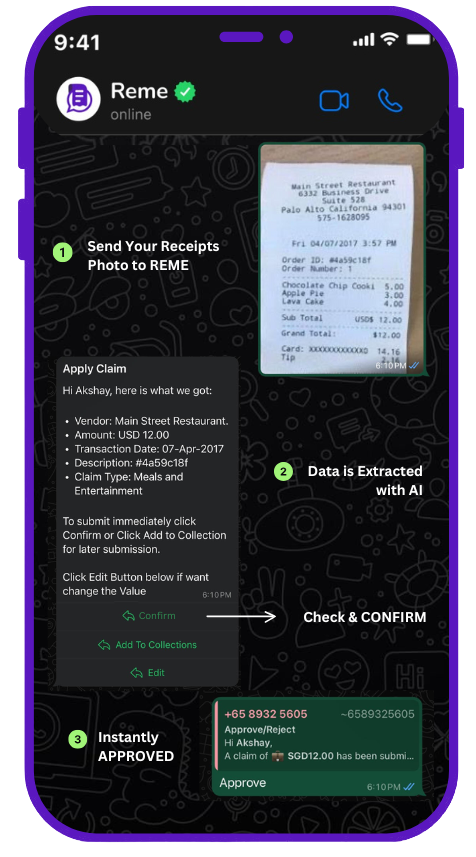In boardrooms across the globe, finance leaders face increasing pressure to justify technology investments with clear return on investment metrics. While many digital transformation initiatives promise nebulous benefits like “improved efficiency” or “enhanced productivity,” modern expense management systems—particularly AI-powered solutions with WhatsApp integration—deliver quantifiable ROI that finance teams can measure, track, and report with confidence.
This comprehensive analysis examines the complete financial impact of implementing a modern expense management solution, revealing both obvious and hidden cost savings that contribute to remarkable returns, often within the first year of implementation.
The True Cost of Traditional Expense Management
Before calculating savings, organizations must understand the full cost of their current expense processes. Many companies significantly underestimate these costs by focusing exclusively on direct expenses while overlooking substantial indirect and opportunity costs.
Direct Costs
Processing Labor: The average expense report costs $58 to process manually, according to the Global Business Travel Association (GBTA). For a company processing 500 reports monthly, that’s $348,000 annually in direct processing costs alone.
Error Correction: The GBTA also found that 19% of expense reports contain errors, requiring an additional $52 per report to correct. For our example company, that’s an additional $59,280 annually.
Fraud Losses: The Association of Certified Fraud Examiners estimates that expense reimbursement fraud accounts for 17% of business fraud, costing the typical organization 5% of annual revenue.
Technology Fees: Legacy expense systems often carry substantial licensing, maintenance, and support fees despite delivering limited functionality.
Paper and Printing: Physical receipts, forms, and documentation generate material costs and storage requirements that accumulate over time.
Indirect Costs
Employee Productivity Loss: The average employee spends 20 minutes completing each expense report. For a company with 200 employees submitting monthly reports, that’s 800 hours of productive time lost annually—equivalent to $40,000 at an average salary of $50/hour.
Finance Team Inefficiency: Finance personnel spend approximately 30% of their time on transaction processing rather than strategic activities that create business value.
Approval Chain Delays: Managers spend an average of 15 minutes reviewing and approving each expense report—time diverted from revenue-generating activities.
Cash Flow Impact: Delayed expense processing creates cash flow visibility gaps that complicate financial forecasting and can lead to suboptimal treasury decisions.
Compliance Risk: Manual processes increase the risk of regulatory non-compliance, potentially resulting in fines and penalties.
ROI Components of Modern Expense Management
Implementing an AI-powered expense management system with WhatsApp integration delivers quantifiable cost savings across multiple dimensions:
1. Process Efficiency Gains
Report Creation Time: AI-powered WhatsApp expense submission reduces report creation time from 20 minutes to under 2 minutes—a 90% efficiency improvement.
Approval Workflow: Automated routing and mobile approval capabilities reduce approval time by 70%, from 15 minutes to less than 5 minutes per report.
Finance Processing: Automatic data extraction, categorization, and accounting system integration reduces finance team processing time by 80%.
Quantifying the Savings: For a company processing 6,000 expense reports annually:
- Employee time saved: 1,800 hours × $50/hr = $90,000
- Manager time saved: 1,000 hours × $75/hr = $75,000
- Finance team time saved: 1,200 hours × $60/hr = $72,000
- Total Annual Efficiency Savings: $237,000
2. Error Reduction Benefits
Manual Error Elimination: AI-powered data extraction achieves 99.7% accuracy compared to 81% for manual entry, virtually eliminating correction costs.
Policy Compliance Improvement: Real-time policy verification increases compliance rates from 80% to 97%, reducing the need for exception handling.
Duplicate Detection: Automated systems identify duplicate submissions that often go undetected in manual processes, typically saving 1-2% of total expense volume.
Quantifying the Savings: For a company with $2M annual expenses:
- Error correction costs avoided: $59,280
- Policy violation reduction: $25,000
- Duplicate submission elimination: $30,000
- Total Annual Error-Related Savings: $114,280
3. Fraud Prevention Value
Automated Verification: AI systems detect patterns and anomalies invisible to human reviewers, identifying potentially fraudulent submissions.
Digital Audit Trails: Comprehensive electronic documentation deters fraud attempts through increased accountability.
Receipt Validation: AI-powered receipt analysis verifies authenticity and matches receipt data to submitted expense data.
Quantifying the Savings: For a $40M revenue company:
- Fraud reduction (conservative 1% estimate): $200,000
- Audit cost reduction: $30,000
- Total Annual Fraud Prevention Value: $230,000
4. Process Acceleration Benefits
Reimbursement Speed: Automated systems reduce reimbursement cycles from 2-3 weeks to 2-3 days, improving employee satisfaction and reducing financial burden.
Month-End Close: Real-time expense processing reduces month-end close time by an average of 2 days.
Cash Flow Visibility: Immediate expense capture provides real-time spending visibility, improving financial forecasting accuracy.
Quantifying the Savings: While harder to directly quantify, conservative estimates include:
- Improved cash management: $25,000
- Faster financial insight value: $40,000
- Employee satisfaction impact: $30,000 (reduced turnover)
- Total Annual Acceleration Benefits: $95,000
5. Integration and Ecosystem Value
Accounting System Integration: Automatic synchronization eliminates manual data transfer between systems.
Travel Platform Connection: Integration with travel booking systems creates end-to-end visibility and control.
Banking Integration: Direct connections with corporate card systems streamline reconciliation.
Quantifying the Savings:
- Integration maintenance savings: $30,000
- Reconciliation effort reduction: $45,000
- Data quality improvement value: $25,000
- Total Annual Integration Value: $100,000
6. Strategic Value Generation
Data-Driven Insights: Expense analytics identify cost-saving opportunities, such as negotiated vendor rates or policy adjustments.
Spend Management: Improved visibility enables more effective budget management and spending control.
Vendor Consolidation: Spending pattern analysis reveals opportunities to consolidate vendors for better rates.
Quantifying the Savings: Based on industry benchmarks:
- Identified savings opportunities: $80,000 (4% of expense volume)
- Budget management improvements: $50,000
- Vendor consolidation benefits: $60,000
- Total Annual Strategic Value: $190,000
Total ROI Calculation
For our example company with 200 employees and $2M in annual expenses:
Total Annual Benefits: $966,280
Typical Implementation Costs:
- Software subscription: $60,000
- Implementation services: $40,000
- Training and change management: $15,000
- Ongoing support: $25,000
- Total Annual Cost: $140,000
Net Annual Benefit: $826,280
ROI Percentage: 590% (Net Benefit ÷ Total Cost)
Payback Period: 2.1 months
Implementation Considerations Affecting ROI
The actual ROI achieved depends significantly on implementation approach and organizational readiness:
Factors That Enhance ROI
Executive Sponsorship: Strong leadership support accelerates adoption and compliance.
Change Management: Comprehensive training and communication increase user adoption rates.
Process Redesign: Reimagining expense workflows rather than digitizing existing processes maximizes efficiency gains.
Integration Depth: Connecting with accounting, HR, and banking systems amplifies value through ecosystem effects.
Data Strategy: Leveraging expense data for strategic decision-making unlocks additional value beyond process efficiency.
Factors That Diminish ROI
Partial Implementation: Implementing only select features or limiting deployment to certain departments reduces overall impact.
Resistance Management: Failing to address employee concerns or resistance extends the adoption timeline.
Technical Isolation: Keeping the expense system disconnected from other business systems limits integration benefits.
Static Policies: Maintaining rigid policies rather than leveraging AI capabilities for dynamic policy application reduces flexibility benefits.
Narrow Focus: Concentrating solely on direct cost savings while ignoring strategic value opportunities limits total return.
ROI by Company Size and Type
While every organization benefits from modern expense management, the ROI profile varies by company characteristics:
Small Businesses (≤50 employees)
Primary ROI Drivers:
- Dramatic reduction in administrative burden
- Elimination of paper-based processes
- Owner/manager time reallocation to strategic activities
Typical Annual ROI: 400-500%
Mid-Market Companies (51-500 employees)
Primary ROI Drivers:
- Process standardization and efficiency
- Policy compliance improvement
- Data visibility for decision making
Typical Annual ROI: 500-700%
Enterprise Organizations (>500 employees)
Primary ROI Drivers:
- Global process consistency
- Fraud reduction at scale
- Strategic spend management
- Integration with complex systems
Typical Annual ROI: 300-500%
Beyond Financial ROI: Secondary Benefits
While financial returns provide compelling justification, additional benefits enhance the total value proposition:
Employee Experience: 87% of employees report higher satisfaction with modern expense processes.
Environmental Impact: Digital receipts and paperless processing reduce paper consumption and carbon footprint.
Talent Attraction: Modern financial systems positively influence candidate perceptions of company progressiveness.
Business Continuity: Cloud-based systems maintain operations during disruptions like the COVID-19 pandemic.
Scalability: Digital systems accommodate business growth without proportional administrative expansion.
Building Your Custom ROI Calculator
To determine the specific ROI potential for your organization, follow these steps:
- Establish Your Expense Baseline:
- Number of expense reports processed monthly
- Average processing time per report
- Error and exception rates
- Total expense volume
- Finance team time allocation
- Quantify Current Costs:
- Direct processing costs
- Error correction expenses
- Estimated fraud losses
- Technology and material costs
- Productivity losses
- Project Implementation Costs:
- Software subscription fees
- Implementation services
- Training and change management
- Ongoing support and maintenance
- Calculate Potential Savings:
- Process efficiency improvements
- Error reduction benefits
- Fraud prevention value
- Acceleration advantages
- Integration and ecosystem value
- Strategic value generation
- Determine ROI Metrics:
- Net annual benefit
- ROI percentage
- Payback period
- Five-year return
Conclusion: The Compelling Business Case for Modern Expense Management
The financial case for implementing AI-powered expense management with WhatsApp integration is compelling by any standard. With ROI often exceeding 500% and payback periods measured in months rather than years, these systems represent one of the highest-return technology investments available to finance organizations today.
Beyond the immediate process efficiencies, modern expense management creates cascading benefits throughout the organization—from improved employee satisfaction to strategic spending insights that drive competitive advantage. The combination of hard cost savings and strategic value generation makes expense management modernization not just fiscally responsible but strategically essential.
As CFOs and finance leaders evaluate digital transformation priorities, expense management modernization stands out for its clear, measurable, and substantial return on investment. In an economic environment where every investment faces intense scrutiny, AI-powered expense management delivers the rare combination of immediate cost savings and long-term strategic value that finance leaders demand.
The question is no longer whether your organization can afford to implement modern expense management—it’s whether you can afford not to.



